Петрология, 2022, T. 30, № 6, стр. 623-643
Великая дайка Кольского полуострова – маркер архейской кратонизации в северной части Фенноскандинавского щита
А. В. Степанова a, *, А. В. Самсонов b, Е. Б. Сальникова c, С. В. Егорова a, Ю. О. Ларионова b, А. А. Арзамасцев c, А. Н. Ларионов d, М. А. Суханова c, Р. В. Веселовский e, f
a Институт геологии КарНЦ РАН
Петрозаводск, Россия
b Институт геологии рудных месторождений, петрографии, минералогии и геохимии РАН
Москва, Россия
c Институт геологии и геохронологии докембрия РАН
Санкт-Петербург, Россия
d Всероссийский научно-исследовательский геологический институт
им. А.П. Карпинского
Санкт-Петербург, Россия
e Институт физики Земли РАН им. О.Ю. Шмидта
Москва, Россия
f Московский государственный университет им. Ломоносова, Геологический факультет
Москва, Россия
* E-mail: stepanov@krc.karelia.ru
Поступила в редакцию 19.05.2022
После доработки 11.06.2022
Принята к публикации 18.06.2022
- EDN: ZIHIWR
- DOI: 10.31857/S0869590322060085
Аннотация
Проведено геохронологическое и петрогенетическое изучение северной части самой крупной мафической дайки северо-восточной части Фенноскандинавского щита, названной Великой дайкой Кольского полуострова (ВДК). Возраст кристаллизации ВДК, определенный по результатам U-Pb (ID-TIMS) датирования бадделеита, составляет 2680 ± 6 млн лет. Возраст вмещающих гранитоидов, по результатам U-Pb (SHRIMP-II) датирования циркона, оценивается в 2.75–2.72 млрд лет. Дайка имеет простое внутреннее строение без признаков многоактного внедрения расплава. Она сложена равномернозернистыми и плагиоклаз-порфировыми долеритами и габбро, в разной степени амфиболитизированными. Все породы имеют низкую магнезиальность (менее 0.37), низкие концентрации Cr и Ni и являются продуктами дифференциации более примитивных расплавов. Анализ геохимических и Sr-Nd изотопных данных позволяет предполагать, что расплавы ВДК могли образоваться при смешении двух типов мантийных магм: деплетированных астеносферных расплавов и обогащенных расплавов, сформированных при плавлении литосферной мантии. Зарождение первичных расплавов ВДК, судя по слабо фракционированным спектрам тяжелых РЗЭ, происходило на небольших (<60 км) глубинах вне поля устойчивости граната. Процессы зарождения расплавов и внедрение неоархейской ВДК происходили вскоре после завершения масштабного гранитного магматизма и главного корообразующего события в Мурманском кратоне и маркируют кратонизацию континентальной литосферы в северо-восточной части Фенноскандинавского щита.
ВВЕДЕНИЕ
Среди мафических даек очень крупные тела протяженностью 100 км и более – мегадайки (Ernst, Bell, 1992) встречаются редко. Эти крупные каналы транспортировки магм представляют интерес, так как позволяют оценить механизмы миграции расплавов при формировании крупных магматических провинций (LIPs). Рои даек и мегадайки формируются в условиях растяжения литосферы и, по мнению исследователей, образование наиболее крупных даек происходит в результате внедрения расплавов в ранее существовавшие ослабленные зоны (Pollard, 1987; Hoek, 1994). В мире известно не так много мегадаек, и почти все они детально изучены. Наиболее известны неоархейская (2575.4 ± 0.7 млн лет; Oberthür et al., 2002) Великая дайка Зимбабве протяженностью более 550 км и максимальной мощностью 11 км, Великая дайка Абитиби (1141 ± 2 млн лет) протяженностью около 700 км в провинции Сьюпериор на Канадском щите (Krogh et al., 1987; Ernst, Bell, 1992), архейская мегадайка Мавритании (2.73 млрд лет; Tait et al., 2013), мезопротерозойская (1629 ± 1 млн лет) дайка в Западной Гренландии (Kalsbeek, Taylor, 1986; Halls et al., 2011). Кливлендская дайка третичного возраста (58.4 ± 1.1 млн лет) представляет собой кулисообразное тело протяженностью 400 км (Macdonald et al., 1988). Внутрикамерная дифференциация, проявленная во всех этих дайках, максимально выражена в дайке Зимбабве, которая рассматривается многими исследователями как расслоенный платиноносный интрузив (Wilson, 1992; Oberthür et al., 2002).
Базиты, в том числе мафические дайки, которые рассматриваются как компонент питающей системы крупных магматических провинций (Ernst et al., 2019), могут фиксировать не только время рифтогереза и аплифта, сопряженного с подъемом мантийных плюмов, но процессы растяжения в задуговых бассейнах, коллапс орогенов и стабилизацию коры, не связанные с подъемом мантийных плюмов (Cottin et al., 1998; Ernst, 2014; Klausen, 2020). Такое многообразие тектонических обстановок формирования базитов позволило М. Клаусену условно разделить крупные магматические провинции на два типа: провинциии “раскола”, формирующихся на этапах фрагментации суперконтинентов, и провинции “сборки”, образование которых субсинхронно с процессами амальгамации суперконтинентов (Klausen, 2020). Помимо геодинамической позиции и соотношений с этапами сборки и раскола суперконтинентов, базиты этих двух типов крупных магматических провинций отличаются и условиями формирования, в частности, составом мантийных источников и вкладом литосферного и плюмового компонентов (Klausen, 2020).
Постколлизионный этап развития складчатых поясов, завершающий орогенный цикл, сопряжен с процессами растяжения и деламинации литосферы и подъема астеносферы и характеризуется масштабной магматической активностью, метаморфизмом и коровым анатексисом (Bonin, 2004). В этом ряду интрузивные базиты являются одним из важных временных и генетических маркеров (Bonin, 2004; Kingsbury et al., 2021; Wang et al., 2022). Вместе с тем внедрение базитов, субсинхронное с формированием гранитоидной ассоциации и пегматитов, характерно и для образований протерозойских анортозит-рапакиви-гранитных ассоциаций (Shumlyanskyy et al., 2021; Johansson et al., 2022). Геодинамическая природа процессов формирования базальтовых расплавов и их соотношения с гранитоидами остаются спорными.
В отличие от обогащенных базитов высоко-К или известково-щелочной серии, тектоническая позиция и условия формирования которых в посторогенных обстановках достаточно хорошо проработаны (Song et al., 2015; Xu et al., 2020 и ссылки в этих работах), генезис базитов толеитовой серии в этих обстановках изучен слабо, а тектоническая позиция дайковых роев и причины, приводящие к такой последовательности формирования расплавов остаются одной из нерешенных проблем. В частности, актуальным является вопрос, маркируют ли рои даек коллапс орогена и окончание цикла Вильсона или являются маркером начала рифтогенеза, нового цикла Вильсона и начала фрагментации суперконтинента (Bonin, 2004; Sun et al., 2022).
В настоящей работе представлены первые данные о составе, строении и возрасте самой крупной из известных к настоящему времени в северо-восточной части Фенноскандинавского щита даек – Великой дайки Кольского полуострова (ВДК). Новые данные о возрасте, геохимических и изотопных характеристиках вмещающих гранитоидов и включений базитов в них являются основой для определения геодинамической позиции ВДК и ее места в истории формирования Мурманского кратона.
РЕГИОНАЛЬНАЯ ГЕОЛОГИЧЕСКАЯ ПОЗИЦИЯ
Кольская часть Фенноскандинавского щита сложена преимущественно архейскими и палеопротерозойскими породами, которые рассматриваются в составе Кольской и Беломорской провинций и Мурманского кратона (Балаганский и др., 2006; Hölttä et al., 2008) (рис. 1а). Породы Кольской и Беломорской провинций, расположенных вблизи палеопротерозойского Лапландско-Кольского коллизионного орогена, были существенно переработаны в ходе орогении 1.93–1.87 млрд лет назад (Балаганский и др., 1998; Daly et al., 2001, 2006). Мурманский кратон выделяется как узкая полоса в северной части Фенноскандинавского щита вдоль побережья Баренцева моря. Он расположен на удалении от Лапландско-Кольского орогена (рис. 1а), что обеспечило его хорошую сохранность от палеопротерозойской тектоно-метаморфической переработки. Граница Кольской провинции и Мурманского кратона представляет собой узкую линейную тектоническую зону и маркируется образованиями зеленокаменного пояса Колмозеро-Воронья (Ранний докембрий …, 2005; Козлов и др., 2006).
Рис. 1.
Геологическое положение ВДК. (а) Тектоническая схема северо-восточной части Фенноскандинавского щита, по (Балаганский и др., 2006) с упрощениями. На врезке схема тектонического районирования Фенноскандии (Hölttä et al., 2008; Bogdanova et al., 2016). (б) Схема геологического строения северо-западной части Мурманского кратона. Составлена с использованием Госгеолкарты масштаба 1 : 200 000 (1957 г.) и Геологической карты Мурманской области масштаба 1:2000000 (2001 г.). (в) Схема геологического строения северного сегмента ВДК и положение отобранных образцов.
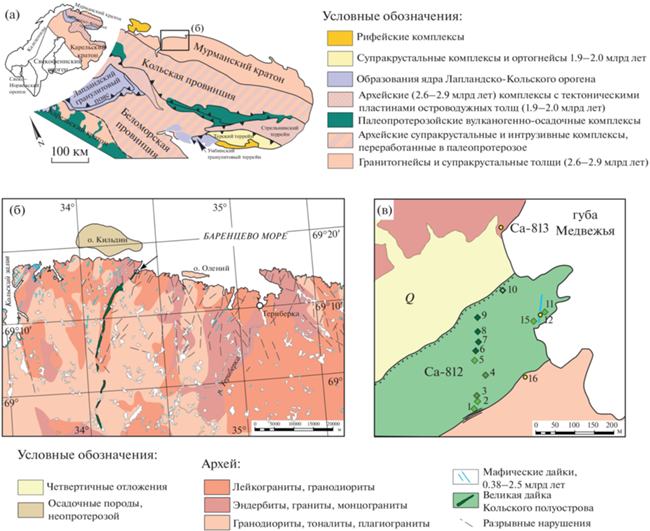
По данным геологического картирования (сводка в работе Козлов и др., 2006), в составе Мурманского кратона преобладают гранитоиды. Наиболее распространены тоналит-трондьемит-гранодиоритовые ортогнейсы и гранитоиды с редкими включениями метабазитов, которые рассматриваются как останцы переработанных зеленокаменных поясов. Субщелочные базиты, диориты, гранодиориты слагают небольшие разобщенные массивы в разных частях Мурманского кратона. Гранодиориты и лейкограниты нормальной щелочности широко распространены в западной части кратона, в районе Териберки, и встречаются в виде небольших массивов на остальной территории (Козлов и др., 2006). Геохронологические данные для эндербитов Канентъяврского массива (2772 ± ± 7 млн лет) и амфиболитов, гнейсов, эндербитов, диоритов, трондьемитов и гранитов в районе Иоканьги (2.72–2.78 млн лет) показывают, что главные корообразующие процессы в Мурманском кратоне происходили в 2.7–2.8 млрд лет (Козлов и др., 2006). По Sm-Nd изотопным данным, гнейсы и гранитоиды из разных частей Мурманского кратона имеют модельные возрасты TNd(DM) от 2.73 до 3.04 млрд лет (Timmerman, Daly, 1995; Козлов и др., 2006; Пожиленко и др., 2018), показывая относительно короткую предысторию коры этого мезо-неоархейского блока континентальной коры.
Архейские гранитоиды Мурманского кратона пересекаются дайками долеритов и оливиновых габбро преимущественно субмеридионального и северо-западного (340°–355°) простирания. По результатам U-Pb датирования бадделеита и циркона из даек и силлов, в Мурманском кратоне установлены как минимум пять возрастных групп базитов: 2.68, 2.50, 1.98, 1.86 и 0.38 млрд лет (Арзамасцев и др., 2009; Федотов и др., 2012; Stepanova et al., 2018; Veselovskiy et al., 2019).
Среди базитовых даек в Мурманском кратоне особое место занимает дайка Зарубихи (Геология СССР. Мурманская область, 1958; Федотов и др., 2012 и ссылки в этих работах) или Великая дайка Кольского полуострова, как ее предложил называть В.С. Куликов (2016 г., личное сообщение). Великая дайка Кольского полуострова (ВДК) расположена в западной части Баренцевоморского побережья Кольского полуострова. Кулисообразное тело северо-восточного простирания 10°–20° прослежено от Медвежьей губы Баренцева моря через оз. Уэлькъявр вдоль р. Зарубихи до оз. Канентъявр (рис. 1б). Протяженность тела более 50 км, мощность 150–700 м, максимальная мощность установлена на южном берегу оз. Уэлькъявр (рис. 1). Кулисообразная морфология тела, вероятно, обеспечивается серией поздних разломов северо-западного простирания (рис. 1б). Нами был изучен самый северный сегмент дайки, обнажающийся в районе Медвежьей губы Баренцева моря (рис. 1в).
МЕТОДЫ ИССЛЕДОВАНИЙ
Изучение петрографических особенностей пород и определение состава минералов проводилось методами оптической микроскопии и на сканирующем электронном микроскопе TESCAN Vega II LSH с приставкой для энергодисперсионного рентгеноспектрального микроанализа Inca Energy-350 в Центре коллективного пользования Карельского научного центра РАН (г. Петрозаводск, ЦКП КарНЦ РАН). Анализ проводился в полированных шлифах, напыленных углеродом (толщина напыления 20 нм) при ускоряющем напряжении 20 кВ и постоянном токе электронного пучка 15 нА ± 0.05 нА. Рабочее расстояние – 15 мм, время накопления спектра – 70 с. При обработке спектров рентгеновского излучения проводилась оптимизация по спектрам простых соединений и стандартизация по набору эталонов породообразующих минералов. Ошибки измерений составили для концентраций свыше 10 мас. % – до 2 отн. %; 5–10 мас. % – до 5 отн. %; от 1 до 5 мас. % – до 10 отн. %.
Содержание петрогенных элементов определялось на рентгенофлюоресцентном спектрометре последовательного действия PW-2400 (Philips Analytical B.V.) в Институте геологии рудных месторождений, петрографии, минералогии и геохимии РАН (г. Москва, ИГЕМ РАН). Анализ проводился в стекловатых дисках, полученных при сплавлении 0.3 г порошка пробы с 3 г тетрабората лития. Потери при прокаливании определялись гравиметрическим методом. Точность анализа составляла 1–5 отн. % для элементов с концентрациями выше 0.5 мас. % и до 12 отн. % для элементов с концентрацией ниже 0.5 мас. %.
Концентрации редких и редкоземельных элементов определялись методом ICP-MS на приборе Thermo Scientific XSeries 2 в ЦКП КарНЦ РАН по стандартной методике (Светов и др., 2015). Разложение образцов проводилось путем кислотного растворения в открытой системе. Правильность анализа контролировалась путем измерения стандартных образцов BHVO-2 и СГД-2А. Результаты измерения стандартных образцов приведены в Supplementary22 1, ESM_1.xls.
Выделение циркона проводилось методами магнитной и плотностной сепарации в лаборатории анализа минерального вещества ИГЕМ РАН. Выделение бадделеита проводилось по водной методике (Söderlund, Johansson, 2002) в ИГЕМ РАН.
Изотопные Rb-Sr и Sm-Nd исследования выполнены в лаборатории изотопной геохимии и геохронологии ИГЕМ РАН. Химическая подготовка вещества для масс-спектрометрических измерений проведена по методике, описанной в (Ларионова и др., 2007). Измерения изотопных отношений проводились на масс-спектрометре Sector 54 (Micromass, Англия) в мультиколлекторном динамическом режиме с использованием трехленточного источника ионов (Thirlwall, 1991). Итоговая погрешность определения 143Nd/144Nd не превышает ±0.0022% с учетом воспроизводимости результатов по внутрилабораторному стандарту Nd-ИГЕМ 0.512400 ± 11 (2σед, N = 24), что соответствует значению 0.511852 в стандарте изотопного состава неодима LaJolla. Погрешность определения 147Sm/144Nd оценивается в ±0.3% (2σед) по результатам измерения стандарта BCR-1. Отношение 87Sr/86Sr в стандарте SRM-987 за время измерительной сессии составило 0.710242 ± 15 (2σед, N = 31). Погрешность 87Rb/86Sr принята равной 1%. При расчетах использованы общепринятые значения констант распада рубидия (Villa et al., 2015).
U-Pb изотопные исследования бадделеита проводились в лаборатории изотопной геологии Института геологии и геохронологии докембрия РАН (г. Санкт-Петербург, ИГГД РАН). Для геохронологических исследований были использованы наиболее прозрачные, однородные кристаллы бадделеита, подвергнутого многоступенчатому удалению поверхностных загрязнений в спирте, ацетоне, 1M HNO3 и 1М HCl. При этом после каждой ступени зерна промывались особо чистой водой. Химическое разложение бадделеита выполнялось по модифицированной методике Т.Е. Кроу (Krogh, 1973) в тефлоновых капсулах, помещенных в резервуар для разложения системы Parr, при этом 202Pb-235U трассер добавлялся непосредственно перед разложением.
Изотопные анализы выполнены на масс-спектрометре TRITON TI при помощи счетчика ионов. Точность определения U/Pb отношений и содержаний U и Pb составила 0.5%. Холостое загрязнение не превышало 1–5 пг Pb и 1 пг U. Обработка экспериментальных данных проводилась с использованием программ “PbDAT” (Ludwig, 1991) и “ISOPLOT” (Ludwig, 2003). При расчете возрастов применялись общепринятые значения констант распада урана (Steiger, Jäger, 1977). Поправки на обычный свинец введены в соответствии с модельными величинами (Stacey, Kra-mers, 1975). Все ошибки приведены на уровне 2σ.
Зерна циркона, выделенные из проб (“неизвестные”) совместно с цирконовыми стандартами (Pb/U, Temora (Black et al., 2003) и концентрации U, 91500 (Wiedenbeck et al., 1995)), были помещены в эпоксидную матрицу (“шайбу”, смола Buehler Epokwick®) и сошлифованы примерно до половины толщины (алмазный абразив 3 мкм). Затем шайба отмывалась от загрязнений и цирконы фотографировались в проходящем и отраженном свете, а также (после напыления слоя золота) с применением BSE и катодолюминесцентного детекторов (СЭМ CamScan MX2500S, UK). Полученные фотографии используются нами для выбора аналитических точек и определения природы цирконов.
In-situ U-Pb анализы выполнялись с использованием SIMS SHRIMP-II в Центре изотопных исследований Всероссийского геологического института (г. Санкт-Петербург, ЦИИ ВСЕГЕИ) в одноколлекторном режиме сканирования по массам в соответствии со стандартным протоколом (Larionov et al., 2004). Размер аналитического кратера составлял 25 × 20 мкм. Замеры ионных токов на девяти массах (196Zr2O к 254UO, четыре масс-спектра на анализ) выполнялись на ВЭУ. Каждый четвертый анализ выполнялся на Pb/U стандарте Temora (1σ неопределенность калибровки стандарта приведена в Supplementary 2, ESM_2.xlsx). Полученные первичные результаты обрабатывались с применением макросов Excel-2003 SQUID v2.50 (Ludwig, 2009) и ISOPLOT/Ex 3.75 (Ludwig, 2012), нерадиогенный Pb скорректирован, используя измеренное 204Pb/206Pb и модельные значения (Stacey, Kramers, 1975), возрасты рассчитаны с константами распада (Steiger, Jäger, 1977). Обсуждаемые в тексте датировки приведены с погрешностью 2σ, результаты индивидуальных анализов в таблицах даны с погрешностью 1σ.
РЕЗУЛЬТАТЫ
Геология и петрография
Северный сегмент базитовой дайки, обнажающийся в районе Медвежьей губы (рис. 1б, 1в), прослежен по простиранию на расстояние более 1 км и имеет мощность около 200 м. Базиты слагают вытянутую в северо-восточном направлении гряду. В западном обрывистом склоне гряды обнажаются тонкозернистые и мелкозернистые долериты, что может указывать на близость к контакту дайки, перекрытому четвертичными отложениями, и на его субвертикальное залегание. Восточный контакт дайки перекрыт рыхлыми отложениями, базиты вблизи контакта рассланцованы. С востока вмещающие породы представлены слабо огнейсованными среднезернистыми трондьемитами (обр. Са-812-16), с запада – микроклиновыми гранитами (обр. Са-813-2), содержащими фрагменты базитов размером до 1 м. Базиты массивны, сложены преимущественно амфиболом, плагиоклазом, биотитом и калиевым полевым шпатом, для них характерно высокое содержание апатита и титанита. В северной части выходов ВДК сечется дайкой амфиболитизированных мелкозернистых долеритов северо-восточного простирания 10°, мощностью около 1.5 м, погружающейся на северо-запад под углом 50°.
Породы ВДК сохранили массивность и слабо рассланцованы лишь в восточной части тела (обр. Са-812-1, 2) (рис. 1в). Зоны рассланцевания выполнены хлоритом и карбонатом, что свидетельствует о низких Р-Т параметрах преобразований, примерно соответствующих зеленосланцевой фации. Наиболее поздние преобразования выражены в формировании тонких пренит-хлоритовых жил. В большинстве изученных образцов в восточной и центральной частях тела пироксены уралитизированы и амфиболизированы, а плагиоклаз соссюритизирован или серицитизирован (рис. 1в, 2). Вместе с тем изученные образцы, за исключением обр. Са-812-1, 2 сохранили реликты первичных клинопироксена и плагиоклаза.
Дайка имеет простое внутреннее строение. Вблизи западного контакта обнажены мелкозернистые долериты пойкилоофитовой структуры, которые вглубь тела сменяются мелкозернистыми долеритами пойкилитовой структуры с редкими вкрапленниками плагиоклаза размером до 3 см. По направлению к центру тела зернистость пород увеличивается, вплоть до крупнозернистых габбро-долеритов и пегматоидных разностей, обнажающихся в обр. Са-812-3, 4 (рис. 1в, 2б, 2в). В пределах изученного сегмента ВДК отсутствуют макроскопические признаки внутрикамерной дифференциации – расслоенность, наблюдается отчетливая и резкая смена составов пород. Преобладают равномернозернистые массивные долериты и габбро (рис. 1в, 2).
Реликтовые минеральные ассоциации позволяют классифицировать породы как габбро, в редких случаях как оливинсодержащие габбро. Клинопироксен в большинстве случаев уралитизирован и обрастает каймой гастингсита (рис. 2г). Пироксены из габбро, долеритов и в основной массе порфировидных пород слабо зональны и представлены авгитом. В крупнозернистых долеритах из центральной части тела они имеют магнезиальность XMg = 0.61–0.65, в пироксенах из краевой части тела XMg = 0.65–0.69 (Supplementary 3, ESM_3.xlsx). Включения клинопироксена в крупных вкрапленниках плагиоклаза представлены диопсидом (XMg = 0.61) и авгитом (XMg = 0.66) (рис. 2б, 3а). Для всех пироксенов характерно умеренное содержание Al и Ti и низкие содержания Na и Cr (Supplementary 2, ESM_2.xlsx).
Рис. 2.
Фотографии шлифов пород ВДК. (а) – метаморфизованный долерит в восточной части тела; (б) – кварц и калиевый полевой шпат в интерстициях крупных зерен амфиболизированного пироксена в пегматоидных долеритах; (в) – реликты авгита и плагиоклаза в пегматоидных долеритах центральной части тела, образец из которого был извлечен бадделеит; (г) – реликтовое зерно авгита в крупнозернистых долеритах. Включения округлой формы в авгите сложены преимущественно оксидами железа; (д) – ойкокристалл авгита в крупнозернистых долеритах, содержащий лейсты интенсивно измененного плагиоклаза; (е) – долерит с крупным зерном замещенного оливина(?), окруженного каймой амфибола. Черное на фото – оксиды железа; (ж) – включения авгита в центральной части крупного вкрапленника плагиоклаза в долеритах западной части тела; (з) – краевая часть крупного вкрапленника плагиоклаза и вмещающие пойкилоофитовые долериты. Символы минералов приведены по (Warr, 2021), Ss – соссюрит, Ser – серицит.
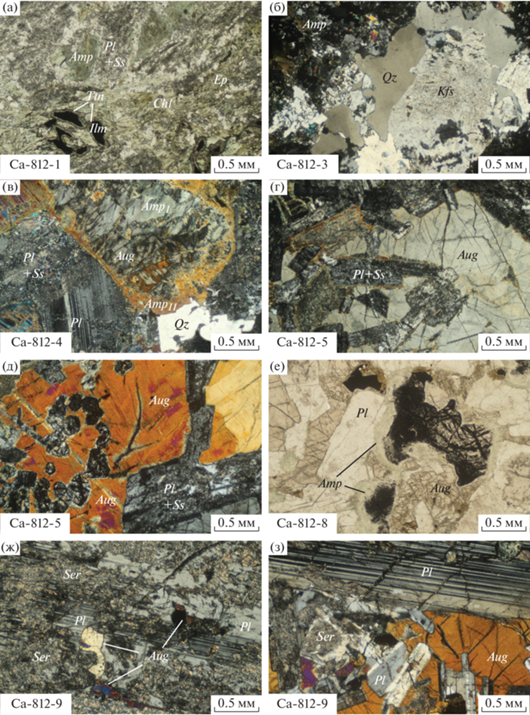
Рис. 3.
Вариации составов клинопироксена и плагиоклаза в породах ВДК. (а) – положение точек составов клинопироксенов на диаграмме волластонит (Wo)–энстатит (En)–ферросилит (Fs) (Morimoto et al., 1988), (б) – вариации состава плагиоклаза, An, % – содержание анортитового минала.
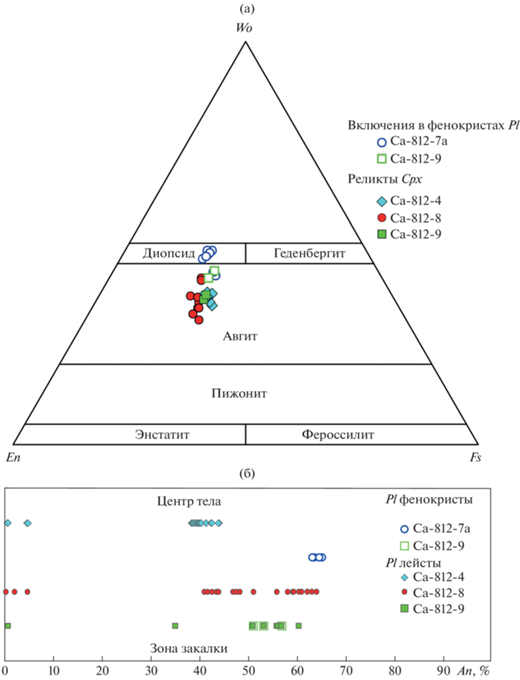
Плагиоклаз слагает до 50% объема долеритов и габбро-долеритов, а также крупные (до 3 см) фенокристаллы в порфировидных породах. Во вкрапленниках плагиоклаз состава An65–60 интенсивно серицитизирован и сохраняется лишь в единичных реликтовых участках (рис. 2ж, 2з). Зональность в фенокристах не диагностируется, лишь краевые части зерен имеют более кислый состав (An50). В остальных случаях плагиоклаз образует крупные лейсты и таблитчатые зерна: слабо зональные (An57–45) крупные зерна, а также более кислые (An35–30) мелкие лейсты. В интерстициях кристаллизуется альбит (An4–8). Оливин в породах не сохранился, однако ойкокристы клинопироксена в породах западной части тела содержат мелкие округлые включения (рис. 2д), которые, судя по форме и характеру замещения, могли быть сложены оливином. Кроме того, породы содержат продукты замещения Fe-Mg минерала, вероятно, оливина, исходя из морфологии зерен, реликтам отдельности, составу продуктов замещения, среди которых преобладают оксиды железа (рис. 2е). Такой характер замещений типичен для оливинов низкой магнезиальности (<0.6). Включения такого типа характерны для пород восточной части тела (обр. Са-812-5, 8). Биотит диагностирован в виде единичных реликтовых зерен в породах хорошей сохранности в центральной части тела. В амфиболитизированных разновидностях биотит формирует кайму вокруг рудных минералов и кристаллизуется совместно с метаморфическим амфиболом. Содержание биотита в породах не превышает первых процентов. Среди рудных фаз преобладает Ti-V магнетит с крупными ламелями ильменита. Во вкрапленниках плагиоклаза и крупных зернах пироксена рудная фаза представлена ильменитом с единичными ламелями оксидов железа. Халькопирит установлен в виде идиоморфных зерен в интерстициях крупных лейст плагиоклаза. Акцессорные апатит, бадделеит и циркон кристаллизовались в интерстициях совместно с кварцем, апатитом и биотитом. Циркон формирует крупные идиоморфные существенно метамиктизированные зерна в пегматоидных разновидностях (рис. 4а, 4б). Бадделеит образует идиоморфные прозрачные и полупрозрачные зерна хорошей сохранности или имеющие оболочки циркона зерна (рис. 4в, 4г).
Рис. 4.
Микрофотографии циркона и бадделеита в пегматоидных долеритах (обр. Са-812-3) (сканирующий электронный микроскоп, фото в обратно-отраженных электронах). Метамиктизированный циркон с включениями торита в кварце (а) и амфиболе (б). Бадделеит со следами замещения цирконом (в, г). Символы минералов по (Warr, 2021).
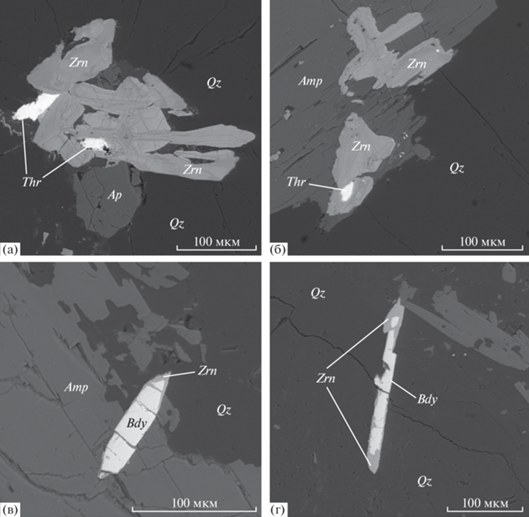
Результаты U-Pb геохронологических исследований
Великая дайка Кольского полуострова. Более 200 зерен бадделеита размером 30–100 мкм было выделено из крупнозернистого долерита, отобранного в центральной части тела (обр. Ca-812-4, рис. 1в). Бадделеит образует пластинчатые и псевдопризматические кристаллы, цвет которых изменяется от светло-коричневого до темно-коричневого. На некоторых кристаллах присутствуют оболочки прозрачного циркона.
Для U-Pb геохронологических исследований были использованы четыре микронавески (1–6 кристаллов) наиболее чистого бадделеита. Как видно из табл. 1 и рис. 5а, бадделеит конкордантен или характеризуется незначительной (1.6–4.8%) прямой возрастной дискордантностью, возможно, связанной с присутствием субмикронных оболочек циркона, образовавшегося в результате наложенных процессов. Конкордантный возраст бадделеита составляет 2680 ± 6 млн лет, СКВО = 0.26, вероятность конкордантности 0.61. Он совпадает с возрастом 2686 ± 6 (СКВО = 1.9), определяемым верхним пересечением дискордии, рассчитанной для все точек изотопного состава; нижнее пересечение соответствует возрасту 1150 ± 130 млн лет).
Таблица 1.
Результаты U-Pb изотопных исследований бадделеита из долеритов ВДК
| № п/п | Размерная фракция (мкм) и характеристика (цвет и габитус) | U/Pb* | Pbc/Pbt | Изотопные отношения | Rho | Возраст, млн лет | ||||||
|---|---|---|---|---|---|---|---|---|---|---|---|---|
| 206Pb/204Pba | 207Pb/206Pbб | 208Pb/206Pbб | 207Pb/235U | 206Pb/238U | 207Pb/235U | 206Pb/238U | 207Pb/206Pb | |||||
| 1 | >45, 6 зер., св.-кор., пласт. | 2.1 | 0.01 | 904 | 0.1777 ± 4 | 0.0132 ± 2 | 11.6277 ± 383 | 0.4746 ± 11 | 0.73 | 2575 ± 7 | 2504 ± 6 | 2631 ± 4 |
| 2 | >45, 5 зер., св.-кор., пласт. | 2.0 | 0.07 | 337 | 0.1798 ± 3 | 0.0146 ± 2 | 12.0859 ± 495 | 0.4874 ± 18 | 0.92 | 2611 ± 10 | 2560 ± 9 | 2651 ± 3 |
| 3 | >45, 3 зер., т-кор., пласт. | 1.7 | 0.09 | 271 | 0.1825 ± 2 | 0.0211 ± 2 | 12.6984 ± 253 | 0.5046 ± 8 | 0.89 | 2658 ± 5 | 2634 ± 5 | 2675 ± 2 |
| 4 | >45, 1 зер., т-кор., пласт. | 1.9 | 0.007 | 406 | 0.1830 ± 3 | 0.0046 ± 2 | 12.9903 ± 780 | 0.5147 ± 20 | 0.92 | 2679 ± 16 | 2677 ± 13 | 2681 ± 4 |
Примечание. *Навеска бадделеита не определялась; Pbc – обычный свинец; Pbt – общий свинец; аизмеренные изотопные отношения; бизотопные отношения, скорректированные на бланк и обычный свинец; Rho – коэффициент корреляции ошибок отношений 207Pb/235U–206Pb/238U. Величины ошибок (2σ) соответствуют последним значащим цифрам.
Рис. 5.
Диаграммы с конкордией, на которых представлены результаты U-Pb геохронологических исследований: (а) – бадделеита (метод ID-TIMS) из долеритов ВДК, обр. Са-812-4; (б) – циркона (метод SIMS, SHRIMP-II) из трондьемита, обр. Са-812-16; (в) – циркона (метод SIMS, SHRIMP-II) из трондьемита, обр. Са-554-3.
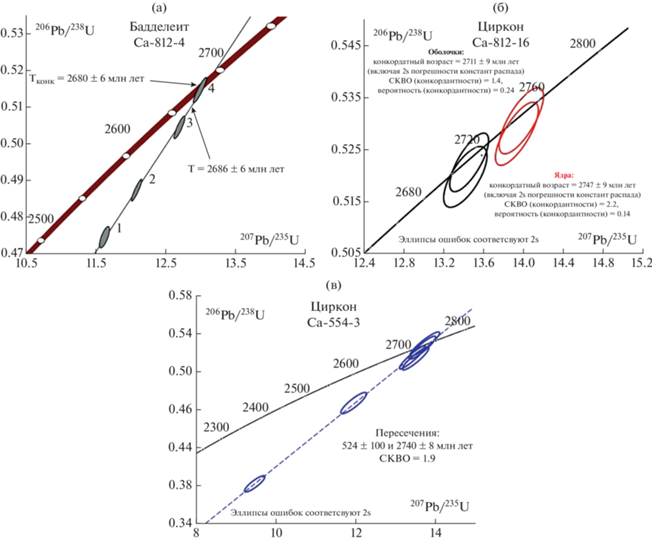
Трондьемит, обр. Са-812-16. Циркон, выделенный из образца трондьемита, отобранного вблизи восточного контакта дайки (рис. 1в), представлен суб- и идиоморфными призматическими и удлиненно-призматическими кристаллами, ребра многих зерен сглажены. В проходящем свете наблюдаются трещины и концентрическая зональность роста, включения немногочисленны. Катодолюми-несцентные (CL) исследования демонстрируют осцилляторную тонкополосчатую зональность, кроме того, нередко обнаруживаются оболочки с низкой интенсивностью люминесценции.
Для U-Th-Pb геохронологических исследований (SHRIMP-II) было использовано 10 зерен циркона, при этом анализировались как ядра, так и оболочки. В отдельных кристаллах (зерно 4 на рисунке в Supplementary 3, ESM3.xlsx) распознаются две разные CL-оболочки (зоны роста). Большинство полученных U-Pb результатов существенно дискордантны, и только для четырех анализов получены конкордантные возрасты, при этом два из них получены для центральных частей зонального циркона, средневзвешенное значение возраста (207Pb/206Pb) которого составляет 2.75 млрд лет (Supplementary 2, ESM_2.xlsx, рис. 5б). Два других анализа участков циркона с невыраженной зональностью (1 край и 1 центр) дают возраст (207Pb/206Pb), <2.72 млрд лет (Supplementary 2, ESM_2.xlsx, рис. 5б). Многочисленные трещины в цирконах могут служить каналами для диффузии радигенного Pb, что объясняет девиацию почти половины результатов (включая полученные из центральных доменов с зональностью роста) от идеальной линии регрессии (СКВО для всех результатов ~6). Таким образом, значение возраста, полученное для незональных цирконов, может являться результатом потери Pb, а не отражать возраст отдельного геологического процесса. Возраст (207Pb/206Pb) ядер, две точки изотопного состава которых располагаются на конкордии (6.1, 3.1) составляет 2747 ± 9 млн лет, а возраст оболочек (4.2, 10.1) соответствует 2711 ± 9 млн лет (рис. 5б, Supplementary 3, ESM_3.xlsx).
Трондьемит, обр. Са-554-3. Из образца трондьемита Са-554-3, отобранного восточнее ВДК, в районе пос. Дальние Зеленцы, выделены субидиоморфные, идиоморфные дипирамидально-призматические, прозрачные цирконы бледно-розовой окраски. В выборке преобладают трещиноватые, нередко с крупными (до 30–50 мкм) полифазными и гомогенными расплавными(?) включениями зерна. В трех из 78 зерен замечены структуры, напоминающие унаследованные ядра. Ростовая зональность, вследствие низкой интенсивности катодолюминесценции (CL), выражена нечетко, однако в некоторых индивидах можно уверенно различить концентрическую осцилляторную и секториальную структуры, указывающие на магматогенную природу цирконов. Низкая интенсивность CL вызвана, по-видимому, нарушенностью структуры (метамиктизацией) и вероятным присутствием примесей. Эти особенности, наряду с обилием включений и заметным удлинением зерен (Кудл = 2.5–4), что предполагает их быстрый рост, могут указывать на формирование данного циркона на позднемагматической стадии. Для этого циркона характерно повышенное содержание урана (300–4650 ppm) (Supplementary 4, ESM_4.xlsx). Для большей части проанализированных зерен (9 из 13) результаты U-Pb анализа сильно дискордантны (D > 7%) и не аппроксимируются единой линией регрессии (СКВО = 65). Соответствующие возрасты, в зависимости от селекции результатов, варьируют от 2730 ± 11 млн лет (два наиболее конкордантных результата) до 2740±8 млн лет (СКВО = 1.9, 6 результатов) (рис. 5в, Supplementary 4, ESM_4.xlsx). Учитывая то, что предполагаемые унаследованные ядра не анализировались, большую из приведенных граничных оценок можно счесть предпочтительной (испытавшей меньшие потери Pb).
Геохимия и Sr-Nd изотопная систематика
Долериты ВДК – это породы основного состава нормальной щелочности толеитовой серии (рис. 6), они характеризуются низкой магнезиальностью (Mg# = 16–37) и концентрацией MgO от 7 мас. % в краевой зоне до 3 мас.% в габбро-пегматитах (табл. 2). Для CaO, Cr и Ni характерны положительные корреляции с MgO, в то время как Fe2O3, TiO2, Zr, Rb и другие несовместимые с базальтовым расплавом элементы демонстрируют отрицательную корреляцию с MgO (рис. 7). В породах, содержащих фенокристы плагиоклаза, наблюдаются более высокие (до 16.7 мас. %) содержания Al2O3 (табл. 2). Для наиболее дифференцированных пород характерен рост содержаний Fe и Ti. Все изученные породы имеют обогащенные спектры легких РЗЭ ((La/Sm)n = 2.1–2.6), слабо фракционированные спектры тяжелых РЗЭ ((Gd/Yb)n = = 1.1–1.7) и отрицательные аномалии высокозарядных элементов, наиболее проявленные для ниобия: Nb/Nb* = 0.19–0.25 (рис. 8а, табл. 2).
Рис. 6.
Положение точек составов долеритов ВДК, вмещающих гранитоидов и включений в них на классификационных диаграммах: (а) – диаграмма TAS (Le Bas et al., 1986), (б) – диаграмма AFM (Irvine, Baragar, 1971).
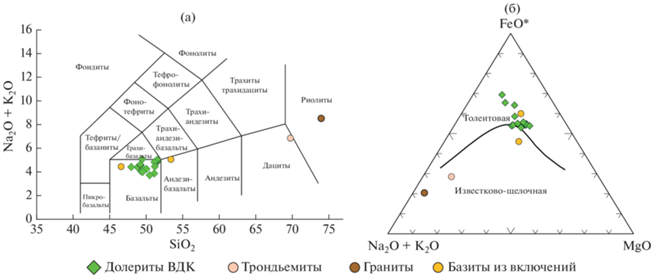
Таблица 2.
Химический состав пород ВДК
| Компоненты | Ca-812-1 | Ca-812-2 | Ca-812-3 | Ca-812-4 | Ca-812-5 | Ca-812-6 | Ca-812-7 | Ca-812-8 | Ca-812-9 | Ca-812-10 | Ca-812-11 | Ca-812-14 | Ca-812-15 |
|---|---|---|---|---|---|---|---|---|---|---|---|---|---|
| 1 | 2 | 3 | 4 | 5 | 6 | 7 | 8 | 9 | 10 | 11 | 12 | 13 | |
| SiO2 | 47.65 | 48.27 | 50.72 | 48.10 | 49.66 | 48.61 | 47.97 | 48.52 | 46.98 | 47.39 | 50.20 | 49.87 | 49.90 |
| TiO2 | 1.33 | 2.01 | 2.34 | 1.94 | 1.17 | 1.19 | 0.98 | 0.98 | 1.15 | 1.09 | 1.09 | 1.15 | 1.18 |
| Al2O3 | 16.32 | 14.59 | 12.95 | 12.71 | 13.87 | 14.25 | 16.42 | 16.64 | 16.15 | 16.65 | 15.40 | 15.61 | 14.83 |
| Fe2O3 | 13.21 | 16.46 | 17.66 | 16.83 | 12.63 | 12.72 | 12.74 | 12.96 | 14.09 | 12.17 | 11.60 | 11.66 | 12.09 |
| MnO | 0.23 | 0.27 | 0.27 | 0.26 | 0.20 | 0.21 | 0.18 | 0.18 | 0.19 | 0.17 | 0.18 | 0.18 | 0.20 |
| MgO | 5.03 | 3.78 | 3.01 | 5.10 | 6.66 | 6.64 | 6.79 | 6.91 | 6.90 | 6.36 | 5.06 | 5.12 | 5.58 |
| CaO | 8.40 | 7.02 | 6.41 | 9.09 | 9.30 | 9.35 | 8.16 | 7.79 | 7.88 | 7.88 | 9.02 | 9.27 | 9.44 |
| Na2O | 3.76 | 3.77 | 3.77 | 3.15 | 2.95 | 3.22 | 3.01 | 2.98 | 3.27 | 3.59 | 3.43 | 3.35 | 3.21 |
| K2O | 0.54 | 1.14 | 1.03 | 1.14 | 0.78 | 0.87 | 0.90 | 0.91 | 1.02 | 0.84 | 1.44 | 1.34 | 1.10 |
| P2O5 | 0.19 | 0.30 | 0.41 | 0.17 | 0.15 | 0.15 | 0.14 | 0.16 | 0.17 | 0.16 | 0.20 | 0.16 | 0.16 |
| П.п.п. | 3.08 | 2.18 | 1.14 | 1.31 | 2.42 | 2.62 | 2.53 | 1.79 | 1.98 | 3.47 | 2.18 | 2.06 | 2.10 |
| Сумма | 99.74 | 99.79 | 99.71 | 99.80 | 99.79 | 99.83 | 99.82 | 99.82 | 99.78 | 99.77 | 99.80 | 99.77 | 99.79 |
| Li | 12.2 | 12.2 | 7.4 | 5.7 | 12.5 | 16.2 | 10.9 | 7.4 | 9.2 | 21.0 | 11.0 | 10.5 | 14.1 |
| V | 278 | 439 | 405 | 384 | 258 | 246 | 170 | 172 | 176 | 167 | 223 | 227 | 248 |
| Cr | 60.5 | 27.2 | 10.3 | 33.7 | 201 | 185 | 80.1 | 60.3 | 50.9 | 47.0 | 94.4 | 97.7 | 121 |
| Co | 54.0 | 47.0 | 45.2 | 59.7 | 56.3 | 52.9 | 65.1 | 70.2 | 68.5 | 64.0 | 44.6 | 42.6 | 44.4 |
| Ni | 74.9 | 34.7 | 17.2 | 64.0 | 83.2 | 76.4 | 147 | 167 | 165 | 154 | 62.5 | 54.8 | 59.8 |
| Cu | 104 | 129 | 99.6 | 228 | 90.2 | 83.4 | 77.2 | 84.7 | 90.9 | 89.1 | 63.2 | 76.8 | 78.7 |
| Zn | 136 | 185 | 183 | 128 | 99.0 | 94.76 | 95.3 | 102 | 106 | 101 | 97.2 | 92.8 | 94.9 |
| Rb | 22.2 | 48.7 | 33.3 | 27.1 | 20.8 | 22.5 | 25.0 | 28.4 | 28.9 | 23.1 | 39.6 | 33.4 | 27.5 |
| Sr | 469 | 333 | 223 | 248 | 304 | 310 | 332 | 340 | 352 | 370 | 344 | 316 | 305 |
| Y | 17.5 | 29.7 | 41.1 | 21.8 | 19.3 | 18.1 | 13.6 | 14.2 | 14.7 | 14.3 | 18.6 | 16.3 | 17.0 |
| Zr | 58.2 | 105 | 196 | 64.0 | 66.4 | 64.4 | 62.7 | 68.2 | 70.4 | 70.9 | 72.7 | 68.6 | 63.3 |
| Nb | 4.18 | 7.03 | 10.2 | 3.75 | 2.89 | 2.80 | 2.66 | 2.75 | 3.13 | 2.97 | 3.57 | 2.79 | 2.77 |
| Ba | 175 | 409 | 766 | 446 | 314 | 334 | 313 | 358 | 397 | 333 | 681 | 559 | 578 |
| La | 14.8 | 23.8 | 34.2 | 14.3 | 12.2 | 12.3 | 11.5 | 12.0 | 13.1 | 12.1 | 15.2 | 12.0 | 11.9 |
| Ce | 31.0 | 50.8 | 73.1 | 23.6 | 20.3 | 20.5 | 19.0 | 19.9 | 21.7 | 21.4 | 25.3 | 21.0 | 20.9 |
| Pr | 3.86 | 6.42 | 8.86 | 4.04 | 3.52 | 3.49 | 3.14 | 3.22 | 3.47 | 3.29 | 4.15 | 3.31 | 3.27 |
| Nd | 15.7 | 25.4 | 36.1 | 17.8 | 15.3 | 15.0 | 13.4 | 13.6 | 14.8 | 14.3 | 17.4 | 14.3 | 14.4 |
| Sm | 3.63 | 5.75 | 8.10 | 4.21 | 3.68 | 3.62 | 3.00 | 3.09 | 3.25 | 3.13 | 3.97 | 3.28 | 3.39 |
| Eu | 1.30 | 1.88 | 2.67 | 1.64 | 1.24 | 1.28 | 1.14 | 1.17 | 1.21 | 1.16 | 1.37 | 1.27 | 1.26 |
| Gd | 3.83 | 6.15 | 8.50 | 4.44 | 3.94 | 3.83 | 3.10 | 3.21 | 3.32 | 3.23 | 4.09 | 3.44 | 3.61 |
| Tb | 0.56 | 0.89 | 1.27 | 0.71 | 0.62 | 0.61 | 0.48 | 0.48 | 0.51 | 0.48 | 0.64 | 0.54 | 0.56 |
| Dy | 3.52 | 5.54 | 7.77 | 4.31 | 3.78 | 3.72 | 2.91 | 2.91 | 3.11 | 2.99 | 3.81 | 3.28 | 3.42 |
| Ho | 0.71 | 1.10 | 1.55 | 0.88 | 0.77 | 0.74 | 0.60 | 0.58 | 0.61 | 0.60 | 0.74 | 0.67 | 0.68 |
| Er | 2.04 | 3.19 | 4.52 | 2.52 | 2.21 | 2.18 | 1.68 | 1.72 | 1.80 | 1.73 | 2.24 | 1.96 | 2.01 |
| Tm | 0.29 | 0.46 | 0.65 | 0.47 | 0.41 | 0.38 | 0.31 | 0.30 | 0.32 | 0.30 | 0.37 | 0.33 | 0.33 |
| Yb | 1.85 | 2.93 | 4.11 | 3.13 | 2.71 | 2.59 | 1.99 | 2.01 | 2.06 | 1.94 | 2.49 | 2.10 | 2.12 |
| Lu | 0.27 | 0.42 | 0.60 | 0.36 | 0.31 | 0.31 | 0.24 | 0.24 | 0.26 | 0.25 | 0.32 | 0.28 | 0.29 |
| Hf | 1.45 | 2.62 | 4.51 | 1.64 | 1.79 | 1.69 | 1.50 | 1.65 | 1.64 | 1.64 | 1.95 | 1.77 | 1.67 |
| Pb | 17.73 | 9.86 | 10.92 | 7.44 | 6.72 | 4.70 | 4.15 | 4.05 | 4.16 | 4.37 | 4.79 | 4.21 | 6.04 |
| Th | 2.76 | 4.60 | 6.53 | 2.60 | 2.24 | 2.22 | 2.13 | 2.05 | 2.28 | 2.17 | 2.49 | 2.17 | 2.14 |
| U | 0.60 | 1.03 | 1.46 | 0.56 | 0.54 | 0.53 | 0.52 | 0.54 | 0.55 | 0.54 | 0.63 | 0.54 | 0.55 |
| Mg# | 0.30 | 0.20 | 0.16 | 0.25 | 0.37 | 0.37 | 0.37 | 0.37 | 0.35 | 0.37 | 0.33 | 0.33 | 0.34 |
| Nb/Nb* | 0.24 | 0.24 | 0.25 | 0.22 | 0.20 | 0.19 | 0.19 | 0.20 | 0.21 | 0.21 | 0.21 | 0.20 | 0.20 |
Примечание. 1 – рассланцованный метаморфизованный долерит, 2 – крупнозернистый габбро-долерит, 3 – крупнозернистый габбро-долерит, 4 – крупнозернистый габбро-долерит, 5 – метаморфизованный габбро-долерит, 6 – габбро-долерит, 7–9 – Pl-порфировый габбро-долерит, 10 – мелкозернистый долерит, 11–13 – габбро-долерит. Mg# = MgO/(MgO + FeOtot), Nb/Nb*= NbPM/(ThPM × LaPM)1/2.
Рис. 7.
Вариации содержаний оксидов петрогенных элементов, Cr и Zr относительно MgO в долеритах ВДК, вмещающих гранитоидах и включениях базитов в них. Положение образцов долеритов ВДК в пределах тела показано соответствующими значками на рис. 1в.
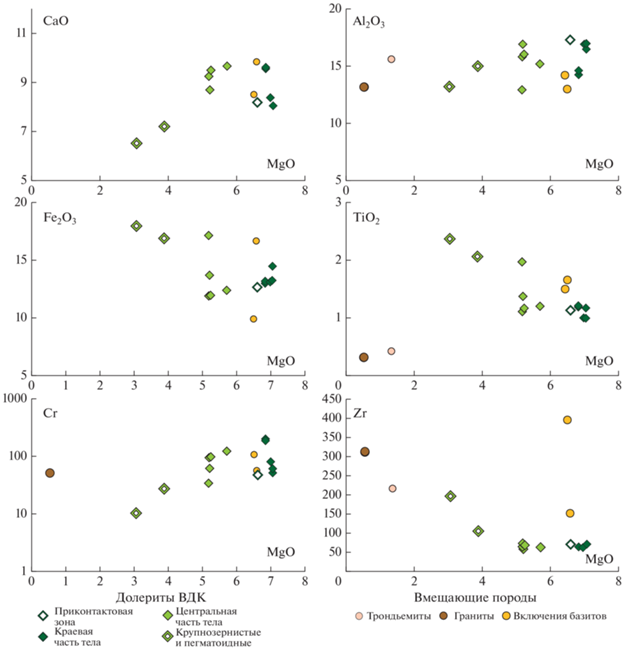
Рис. 8.
Характер распределения рассеянных и редкоземельных элементов в долеритах ВДК, вмещающих гранитоидах и включениях в них, базальтах и коматииитах архейских зеленокаменных поясов Кольско-Норвежской провинции (зеленое поле, Вревский, 2018), базальтах D-MORB (Klein, 2003) и OIB (Sun, McDonough, 1989). Нормирование по (McDonough, Sun, 1995).

Вмещающие гранитоиды отвечают по составу трондьемитам и гранитам и имеют составы, типичные для гранитоидов западной части Мурманского кратона (Козлов и др., 2006). Мафические включения в гранитах по составу отвечают умеренно-магнезиальным (MgO = 6.5 мас. %) базальтам нормального ряда щелочности c высоким содержанием P2O5, аномально высокими концентрациями большинства несовместимых элементов и резкой отрицательной Eu-аномалией и всех высокозарядных элементов (рис. 8, Supplementary 5, ESM_5.xlsx).
Первичный изотопный состав неодима в базитах, отобранных их разных частей ВДК, имеет небольшие вариации величин ɛNd(2680) от –0.14 до +0.56 (табл. 3). Первичный изотопный состав стронция в базитах варьирует в широких пределах (87Sr/86Sr)2680 от 0.7000 до 0.7075 (табл. 4).
Таблица 3.
Sm-Nd изотопные данные для базитов ВДК и вмещающих гранитоидов
| Номер образца | Порода | Sm | Nd | 147Sm/144Nd | 143Nd/144Nd | ±2s | T*, млн лет | ԑNd(T) | T(DM)** |
|---|---|---|---|---|---|---|---|---|---|
| Са-812-1 | Рассланцованный метадолерит | 3.77 | 17.0 | 0.13423 | 0.511546 | 0.000006 | 2680 | 0.24 | 3060 |
| Са-812-4 | Крупнозернистый долерит | 3.46 | 14.9 | 0.14045 | 0.511672 | 0.000006 | 2680 | 0.56 | 3059 |
| Са-812-9 | Pl-порфировый долерит | 3.01 | 13.8 | 0.13183 | 0.511509 | 0.000007 | 2680 | 0.35 | 3039 |
| Са-812-10 | Мелкозернистый долерит | 2.79 | 12.8 | 0.13197 | 0.511486 | 0.000007 | 2680 | -0.14 | 3085 |
| Ca-812-16 | Трондьемит | 3.94 | 27.8 | 0.08552 | 0.510629 | 0.000005 | 2750 | 0.17 | 2980 |
| Са-813-2 | Гранит | 7.61 | 63.7 | 0.07216 | 0.510429 | 0.000005 | 2720 | 0.52 | 2913 |
Таблица 4.
Rb-Sr изотопные данные для базитов ВДК и вмещающих гранитоидов
| Номер образца | Порода | Rb | Sr | 87Rb/86Sr | 87Sr/86Sr | ±2s | T*, млн лет | (87Sr/86Sr)T |
|---|---|---|---|---|---|---|---|---|
| Са-812-1 | Рассланцованный метадолерит | 21.7 | 483 | 0.1301 | 0.712510 | 0.000015 | 2680 | 0.707462 |
| Са-812-4 | Крупнозернистый долерит | 32.6 | 297 | 0.3171 | 0.713631 | 0.000010 | 2680 | 0.701333 |
| Са-812-9 | Pl-порфировый долерит | 34.1 | 386 | 0.2562 | 0.709973 | 0.000009 | 2680 | 0.700035 |
| Са-812-10 | Мелкозернистый долерит | 27.7 | 402 | 0.1993 | 0.711212 | 0.000009 | 2680 | 0.703483 |
| Ca-812-16 | Трондьемит | 104 | 438 | 0.6846 | 0.725865 | 0.000014 | 2680 | 0.699310 |
| Са-813-2 | Гранит | 108 | 300 | 1.0422 | 0.745344 | 0.000009 | 2680 | 0.704918 |
Гранитоиды в западном и восточном обрамлении ВДК, в пересчете на возраст внедрения дайки (2680 ± 6 млн лет), имеют меньшие по сравнению с базитами величины ɛNd от –0.13 до –0.84 и (87Sr/86Sr)2680 от 0.6993 в трондьемите до 0.7049 в граните (табл. 3, 4).
ОБСУЖДЕНИЕ
Возрастная позиция ВДК в истории формирования Мурманского кратона
Возраст внедрения ВДК надежно установлен по результатам датирования бадделеита и составляет 2680 ± 6 млн лет. Менее определенным является возраст вмещающих гранитоидов. В трондьемите циркон потерял большую часть радиогенного свинца, и лишь единичные сохранные участки кристаллов дают две оценки возраста. Более древний возраст 2.75 млрд лет назад, по-видимому, соответствует возрасту протолита трондьемита и определяет время магматической кристаллизации. Значение более молодого возраста (2.72 млн лет), полученного по незональным краевым и центральным участкам зерен, вследствие возможных потерь свинца, остается неопределенным. Можно предположить, что более молодой возраст отвечает времени эндогенной переработки протолита, которая была либо связана с внедрением массивов поздних двуполевошпатовых гранитов, которые имеют в регионе широкое распространение и завершают неоархейский кислый магматизм в западной части Мурманского кратона, либо с метаморфическими преобразованиями, возможно, являющимися следствием термальной переработки при внедрении даек базитов.
Базиты ВДК контрастно отличаются от базитов из включений в гранитах, прежде всего более низкими концентрациями рассеянных и редкоземельных элементов (рис. 7, 8). Они также контрастно отличаются от метабазитов архейских зеленокаменных поясов полосы Ура-Губа–Колмозеро–Воронья (Вревский, 2018). Базиты зеленокаменных поясов значительно более магнезиальны, а концентрации рассеянных элементов в них существенно более низкие, чем в долеритах ВДК (рис. 8). Столь значимые различия составов пород свидетельствуют о том, что базиты ВДК представляют отдельный самостоятельный эпизод архейского основного магматизма в истории формирования Мурманского кратона. Включения, аналогичные по морфологии и составу включениям в гранитах, вмещающих ВДК, широко развиты в разных частях Мурманского кратона (Козлов и др., 2006 и наши данные). В отдельных участках такие включения формируют ореолы вокруг небольших базитовых массивов или цепочки на простирании базитовых даек. Морфологические особенности базитовых включений и их повсеместная ассоциация с гранитами (Козлов и др., 2006), обогащенный характер базитов, типичный для санукитодиной серии (Ларионова и др., 2007) могут указывать на одновременное внедрение базитовых и кислых магм без их смешивания, т.е. на минглинг (Wilcox, 1999). Такой процесс в фанерозое наиболее характерен для постколлизионных обстановок при распаде коллизионных орогенов (Скляров, Федоровский, 2006).
Полученные нами и опубликованные ранее данные о возрасте гранитов 2.72–2.75 млрд лет в других частях Мурманского кратона (Козлов и др., 2006) указывают на относительно небольшой, от 20 до 50 млн лет, возрастной интервал между завершением корообразующих процессов в Мурманского кратоне и внедрением ВДК. Значительная мощность и протяженность ВДК являются отражением высокой интенсивности процессов растяжения при формировании дайки, а наличие закаленных пород в контактовой части тела свидетельствуют о существенном температурном градиенте магм ВДК и вмещающих гранитоидов. Внедрение крупных мафических даек сразу после главного корообразующего события – довольно распространенное явление для докембрийских щитов. Так, считается, что Великая дайка Зимбабве маркирует завершение корообразующих процессов в кратоне Зимбабве (Oberthür et al., 2002). Этап стабилизации континентальной коры и завершение корообразующих процессов маркируют и неоархейские мафические дайки в Северо-Китайском кратоне и кратоне Илгарн (Li et al., 2010; Stark et al., 2018).
Внутрикамерная эволюция базитового расплава ВДК
Несмотря на проявленную в большинстве образцов частичную амфиболизацию пироксена и соссюритизацию плагиоклаза, большая часть пород сохранила реликты первичных минералов и структур (рис. 2). Породы сохранили также первичные геохимические и изотопные характеристики. Исключением являются рассланцованные и хлоритизированные метабазиты вблизи восточного контакта дайки (обр. Са-812-1, рис. 2а). В этих породах изменения выражены в уменьшении содержаний K2O, Rb и в значительных незакономерных вариациях первичного изотопного состава стронция, свидетельствующих о нарушении Rb-Sr изотопной системы (табл. 2, 3).
Постепенные изменения состава пород от краев к центру дайки, отсутствие внутренних зон закалки и других свидетельств многократного внедрения расплавов свидетельствует о формировании ВДК в результате одного эпизода внедрения магм. При кристаллизации этого большого объема магмы внутрикамерная дифференциация имела место, но степень дифференциации in situ была незначительна – в породах не выявлены расслоенность, кумулятивные структуры, являющиеся признаками процессов фракционной кристаллизации. Вместе с тем процессы внутрикамерной дифференциации обусловили высокие концентрации несовместимых элементов в низкомагнезиальных породах центральной части тела (рис. 7, 8), что связано с их накоплением в остаточных расплавах. Рост содержания Al2O3 в ряде образцов в значительной степени обусловлен наличием фенокристов плагиоклаза в породах.
Зоны закалки и породы краевой части тела являются индикаторными в отношении расплавов, поступавших в камеру. Судя по составу пород, эти расплавы имели низкую магнезиальность (Mg# = 37) и не могли быть в равновесии с мантийными породами, что предполагает существование промежуточной камер(ы), где происходила дифференциация первичных расплавов. О наличии промежуточной камеры и относительно небольшой глубины ее заложения свидетельствует также наличие фенокристов плагиоклаза (Presnall et al., 1978).
Оценка состава источников ВДК
Результаты петрографических исследований и особенности составов базитов, такие как низкие содержания MgO, Cr и Ni, указывают, что магмы, формировавшие ВДК, претерпели дифференциацию и не представляют расплавов, равновесных с мантийным источником. Согласно данным по фенокристам, дифференциация проходила как минимум в два этапа: в питающей дайку малоглубинной камере и в более глубокой промежуточной камере, где были сформированы главные черты состава расплавов.
Полученные геохимические данные дают ряд ограничений на особенности состава первичных магм. Наиболее магнезиальные базиты ВДК имеют очень слабо фракционированные спектры тяжелых РЗЭ ((Gd/Yb)n = 1.2–1.3), что указывает на безгранатовый источник первичных расплавов и ограничивает глубину их зарождения 60 км. Обогащенные спектры легких РЗЭ в сочетании с резкими отрицательными Nb-аномалиями и умеренно радиогенным изотопным составом неодима (табл. 3, рис. 9) служат указанием на вклад древнего обогащенного литосферного источника, который мог быть представлен архейскими гранитоидами и/или литосферной мантией, претерпевшей обогащение несовместимыми элементами в процессе надсубдукционной переработки. К таким же выводам приводит анализ данных по концентрациям Ti, Th и Yb (рис. 10). Отношение Th/Nb позволяет косвенно оценить вклад коровой контаминанты и(или) литосферного источника, а отношение TiО2/Yb – наличие граната в источнике и глубину плавления. Сочетание этих параметров отражает вклад плюмового и литосферного источников в генезис расплавов (Pearce et al., 2021). Положение точек составов пород ВДК на рис. 10 показывает, что первичные расплавы могли быть сформированы при участии подлитосферных мантийных источников и обогащенной субконтинентальной литосферной мантии (SZLM).
Рис. 9.
Диаграмма ԑNd–Возраст для долеритов ВДК и вмещающих гранитоидов. Поле эволюции изотопного состава неодима для архейских гнейсов и гранитоидов западной части Мурманского кратона по данным (Timmerman, Daly, 1995; Козлов и др., 2006; Пожиленко и др., 2018). DM – линия эволюции деплетированной мантии по (Goldstein, Jacobsen, 1987).
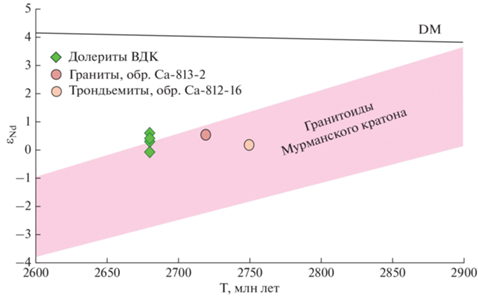
Рис. 10.
(а) Положение точек составов базитов на диаграмме Пирса (Pearce et al., 2021). MORB – базальты срединно-океаничеcких хребтов, OPB – океанические платобазальты, OIB – базальты океанических островов, IAB – островодужные базальты, FAB – преддуговые базальты, SZLM – субдукционно модифицированная литосферная мантия. (б) Деталь рис. (а). Здесь и далее данные для MORB из работы (Klein, 2003).
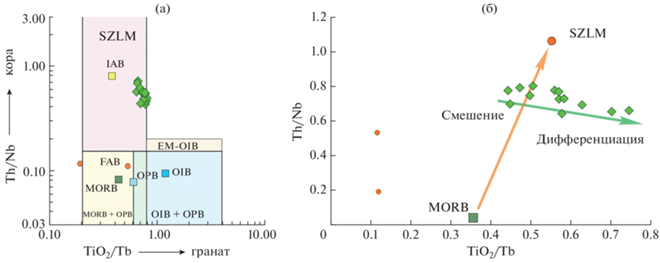
Небольшие глубины зарождения первичных расплавов ВДК в области безгранатового рестита, определяемые низкими величинами (Gd/Yb)n и TiO2/Yb, предполагают участие малоглубинного астеносферного источника. В качестве представителя SZLM можно принять обогащенный литосферный источник, из которого образовались базиты предшествовавшей внедрению ВДК стадии, сопряженные с гранитами. Следует подчеркнуть, что проанализированные нами базиты из небольших включений во вмещающих гранитах, вероятно, претерпели значительные преобразования при взаимодействии с окружающим гранитным расплавом, и их геохимические характеристики непредставительны для SZLM (рис. 11б). Более сохранные метабазиты и метадиориты с возрастом 2.72 млн лет, которые можно рассматривать как производные обогащенной литосферной мантии, представлены в центральной части Мурманского кратона в районе мыса Лицкий (Samsonov et al., 2019).
Рис. 11.
Оценка параметров смешения расплавов, образованных в результате плавления деплетированного астеносферного и обогащенного литосферного источников, в сравнении с характеристиками базитов ВДК, на основании изотопных (а) и геохимических (б) данных. Смесь базит–D-MORB представляет результат масс-балансового расчета при оценке состава, получаемого в результате смешения 70% расплава, отвечающего по составу D-MORB, и 30% расплава, соответствующего неоархейским диоритам Мурманского кратона. Исходные составы приведены в Supplementary, ESM_6.xlsx.
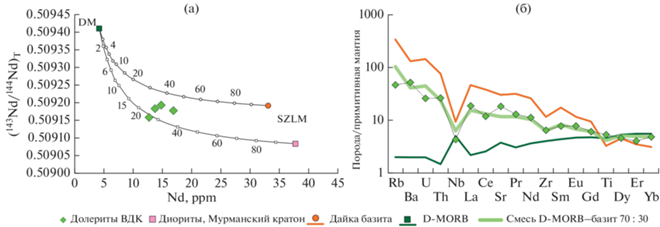
Масс-балансовые расчеты показывают, что составы, аналогичные наиболее примитивным образцам ВДК, могли быть получены при смешении 70% астеносферного расплава с характеристиками D-MORB (Klein, 2003) и 30% расплава, производного из обогащенной литосферной мантии (рис. 11а). Близкие величины вклада астеносферного и литосферного источника дают расчеты с использованием Sm-Nd изотопно-геохимических данных (рис. 11б) (Supplementary 6, ESM_6.xls).
В качестве возможных механизмов формирования источника, имеющего геохимические SZLM характеристики, в работе (Pearce et al., 2021) рассматриваются процессы (1) деламинации литосферы или (2) плавление SCLM в результате подъема высокотемпературного глубинного плюма. Полученные нами данные и результаты расчетов лучше согласуются с моделью деламинации литосферы со смешением астеносферного и литосферного расплавов (Wang, Currie, 2015).
Корреляции неоархейского дайкового магматизма на Фенноскандинавском и других щитах мира
Несмотря на то, что еще пятнадцать лет назад архейские мафические дайки и крупные магматические провинции были практически не известны в мире (Bleeker, Ernst, 2006), к настоящему времени неоархейские мафичеcкие дайки датированы на многих кратонах. На Канадском щите наиболее близкими по возрасту к ВДК являются дифференцированный интрузив Стиллуотер и мафические дайки кратона Вайоминг, относящиеся к событию Стиллуотер–Рандеву (Ernst et al., 2021). Дайки и силлы с возрастом в интервале 2.72–2.70 млрд лет известны на кратонах Зимбабве, Илгарн и Слэйв, где они рассматриваются как компонент события Goldfield Super tholeiitic event (Hayman et al., 2015; Austin, 2022).
На Карельском кратоне мафические дайки с возрастом 2.7 млрд лет к настоящему времени неизвестны. Вместе с тем в Беломорской провинции известны дайка близкого возраста (2670 ± 10 млн лет, Балаганский и др., 1990) и интрузив о. Супротивные (2711 ± 25 млн лет) (Слабунов и др., 2008). Имеющихся к настоящему времени данных недостаточно для оценки масштабов события с возрастом около 2.7 млрд лет на Фенноскандинавском щите, однако наличие мегадаек является одним из важных критериев при реконструкции крупных магматических провинций (Ernst et al., 2021) и позволяет предполагать существование неоархейской крупной магматической провинции в северо-восточной части Фенноскандинавского щита.
ВЫВОДЫ
1. Возраст кристаллизации Великой дайки Кольского полуострова, определенный по результатам U-Pb (ID-TIMS) датирования бадделеита составляет 2680 ± 6 млн лет. U-Pb возраст цирконов из вмещающих гранитоидов (SHRIMP-II) находится в интервале 2.72–2.75 млрд лет.
2. В изученном северном сегменте ВДК сложена низкомагнезиальными базитами толеитовой серии нормального ряда щелочности, имеет простое строение и сформирована в результате одноактного внедрения расплава.
3. Формирование первичных расплавов ВДК могло происходить при смешении деплетированного астеносферного и обогащенного литосферного расплавов при деламинации литосферы.
4. ВДК маркирует окончание архейских орогенических процессов и кратонизацию неоархейской континентальной литосферы в северо-восточной части Фенноскандинавского щита.
Благодарности. Наши исследования были проведены во многом благодаря энциклопедическим знаниям В.С. Куликова и его живому интересу к геологии Фенноскандии. Обсуждение с Вячеславом Степановичем проблем основного дайкового магматизма Фенноскандинавского щита подтолкнули нас к изучению Великой дайки Кольского полуострова – важного, но забытого на десятилетия объекта. Проведение экспедиционных работ и сбор коллекции каменного материала стали возможны благодаря помощи команды судна “Удача” О.У. Мингазова и Г.И. Мухина. Конструктивные замечания рецензентов А.А. Носовой и Н.М. Кудряшова позволили существенно улучшить статью.
Источники финансирования. Исследования выполнены при поддержке Российского научного фонда (проект № 16-17-10260П).
Список литературы
Арзамасцев А.А., Федотов Ж.А., Арзамасцева Л.В. Дайковый магматизм северо-восточной части Балтийского щита. М.: Наука, 2009. 379 с.
Балаганский В.В., Бибикова Е.В., Богданова С.В. и др. U-Pb геохронология беломорид района Тупой губы оз. Ковдозеро (Северная Карелия) // Изв. Ан СССР. Сер. геол. 1990. № 6. С. 40–51.
Балаганский В.В., Глазнев В.Н., Осипенко Л.Г. Раннепротерозойская эволюция Северо-Востока Балтийского щита: террейновый анализ // Геотектоника. 1998. № 2. С. 16–28.
Балаганский В.В., Минц М.В., Дэйли Д.С. Палеопротерозойский Лапландско-Кольский ороген // Строение и динамика литосферы Восточной Европы. Результаты исследований по программе EUROPROBE. М.: Геокарт, 2006. С. 158–171.
Вревский А.Б. Особенности проявления неоархейских плюм-литосферных процессов в Кольско-Норвежской провинции Фенноскандинавского щита: петрология и геодинамическая природа коматиит-толеитовой ассоциации // Петрология. 2018. Т. 26. № 3. С. 245–254.
Геология СССР. Мурманская область. М.: Госгеолтехиздат, 1958. 725 с.
Козлов Н.Е., Сорохтин Н.О., Глазнев В.Н. и др. Геология архея Балтийского щита. СПб.: Наука, 2006. 345 с.
Ларионова Ю.О., Самсонов А.В., Шатагин К.Н. Источники архейских санукитоидов (высоко-Mg субщелочных гранитоидов) Карельского кратона: Sm-Nd и Rb-Sr изотопно-геохимические данные // Петрология. 2007. Т. 15. № 6. С. 571–593.
Пожиленко В.И., Серов П.А., Петров В.П. Sm-Nd изотопные исследования раннедокембрийских пород Кольского региона: краткий обзор и новые данные // Вест. Кольского НЦ РАН. 2018. № 1(10). С. 37–49.
Ранний докембрий Балтийского щита // Под ред. В.А. Глебовицкого. СПб.: Наука, 2005. 711 с.
Светов С.А., Степанова А.В., Чаженгина С.Ю. и др. Прецизионный (ICP-MS, LA-ICP-MS) анализ состава горных пород и минералов: методика и оценка точности результатов на примере раннедокембрийских мафитовых комплексов // Тр. Карельского НЦ РАН. 2015. № 7. С. 173–192.
Скляров Е.В., Федоровский В.С. Тектонические и геодинамические аспекты механического смешения магм (магматического минглинга) // Геотектоника. 2006. № 2. С. 47–64.
Слабунов А.И., Степанова А.В., Бибикова Е.В. и др. Неоархейские габброиды Беломорской проввинции Фенноскандинавского щита: геология, состав, геохронология // Докл. АН. 2008. Т. 422. № 6. С. 793–797.
Федотов Ж.А., Баянова Т.Б., Серов П.А. Пространственно-временные закономерности проявления дайкового магматизма Kольского региона // Геотектоника. 2012. № 6. С. 29–45.
Austin J.M., Hayman P.C., Murphy D.T. et al. The voluminous 2.81–2.71 Ga goldfields tholeiitic super event: Implications for basin architecture in the Yilgarn Craton and global correlations // Precambr. Res. 2022. V. 369. P. 106528.
Black L.P., Kamo S.L., Allen C.M. et al. TEMORA 1: A new zircon standard for Phanerozoic U-Pb geochronology // Chem. Geol. 2003. V. 200. № 1–2. P. 155–170.
Bleeker W., Ernst R.R.E. Short-lived mantle generated magmatic events and their dyke swarms: The key unlocking Earth’s paleogeographic record back to 2.6 Ga // Dyke Swarms – Time Markers of Crustal Evolution. Proceed. Fifth Int. Dyke Conference. 2006. P. 3–26.
Bogdanova S.V., Gorbatschev R., Garetsky R.G. EUROPE|East European Craton // Reference Module in Earth Systems and Environmental Sciences. 2016. https://doi.org/10.1016/B978-0-12-409548-9.10020-X
Bonin B. Do coeval mafic and felsic magmas in post-collisional to within-plate regimes necessarily imply two contrasting, mantle and crustal, sources? A review // Lithos. 2004. V. 78. № 1. P. 1–24.
Corfu F., Hanchar J.M., Hoskin P.W.O. et al. Atlas of zircon textures // Rev. Mineral. Geochem. 2003. V. 53. P. 469–499.
Cottin J.Y., Lorand J.P., Agrinier P. et al. Isotopic (O, Sr, Nd) and trace element geochemistry of the Laouni layered intrusions (Pan-African belt, Hoggar, Algeria): Evidence for post-collisional continental tholeiitic magmas variably contaminated by continental crust // Lithos. 1998. V. 45. № 1–4. P. 197–222.
Daly J.S., Balagansky V.V., Timmerman M.J., Whitehouse M.J. The Lapland-Kola orogen: Palaeoproterozoic collision and accretion of the northern Fennoscandian lithosphere // Geol. Soc. London. Memoirs. 2006. V. 32. P. 579–598. https://doi.org/10.1144/GSL.MEM.2006.032.01.35
Daly J.S., Balagansky V.V., Timmerman M.J. et al. Ion microprobe U-Pb zircon geochronology and isotopic evidence for a trans-crustal suture in the Lapland – Kola Orogen, northern Fennoscandian Shield // Precambr. Res. 2021. V. 105. P. 289–314. https://doi.org/10.1016/S03019268(00)00116-9
Ernst R.E. Large Igneous Provinces. Cambridge University Press, 2014. 667 p.
Ernst R.E., Bell K. Petrology of the Great Abitibi Dyke, Superior // J. Petrol. 1992. V. 33. № 2. P. 423–469.
Ernst R.E., Liikane D.A., Jowitt S.M. et al. A new plumbing system framework for mantle plume-related continental large igneous provinces and their mafic-ultramafic intrusions // J. Volcanol. Geotherm. Res. 2019. V. 384. P. 75–84.
Ernst R.E., Bond D.P.G., Zhang S. et al. Large igneous pro-vince record through time and implications for secular environmental changes and geological time-scale boundaries // Large Igneous Provinces: A Driver of Global Environmental and Biotic Changes. 2021. P. 1–26.
Goldstein S.J., Jacobsen S.B. The Nd and Sr isotopic systematics of river-water dissolved material: Implications for the sources of Nd and Sr in seawater // Chem. Geol. Isot. Geosci. Sect. 1987. V. 66. № 3. P. 245–272.
Halls H.C., Hamilton M.A., Denyszyn S.W. The Melville Bugt dyke swarm of greenland: A connection to the 1.5–1.6 Ga Fennoscandian Rapakivi Granite Province? // BT – Dyke Swarms: Keys for Geodynamic Interpretation: Keys for Geodynamic Interpretation. Ed. R.K. Srivastava. Berlin, Heidelberg: Springer Berlin Heidelberg, 2011. P. 509–535.
Hayman P.C., Thébaud N., Pawley M.J. et al. Evolution of a ~2.7 Ga large igneous province: A volcanological, geochemical and geochronological study of the Agnew Greenstone Belt, and new regional correlations for the Kalgoorlie Terrane (Yilgarn Craton, Western Australia) // Precambr. Res. 2015. V. 270. P. 334–368.
Hoek J.D. Mafic dykes of the Vestfold Hills, East Antarctica. An analysis of the emplacement mechanism of tholeiitic dyke swarms and of the role of dyke emplacement during crustal extension: PhD thesis. Utrecht University, 1994.
Hölttä P., Balagansky V., Garde A. Archean of Greenland and Fennoscandia // Episodes. 2008. V. 31. № 1. P. 13–19.
Irvine T.N., Baragar W.R.A. A Guide to the chemical classification of the common volcanic rocks // Canada J. Earth Sci. 1971. V. 8. P. 523–548.
Johansson Å., Bingen B., Huhma H. et al. A geochronological review of magmatism along the external margin of Columbia and in the Grenville-age orogens forming the core of Rodinia // Precambr. Res. 2022. V. 371. P. 106463
Kalsbeek F., Taylor P.N. Chemical and isotopic homogeneity of a 400 km long basic dyke in central West Greenland // Contrib. Mineral. Petrol. 1986. V. 93. № 4. P. 439–448.
Kingsbury C.G., Klausen M.B., Söderlund U. et al. Identification of a new 485 Ma post-orogenic mafic dyke swarm east of the Pan-African Saldania-Gariep Belt of South Africa // Precambr. Res. 2021. V. 354. P. 106043.
Klausen M.B. Conditioned duality between supercontinental ‘assembly’ and ‘breakup’ LIPs // Geosci. Front. 2020. V. 11. № 5. P. 1635–1649.
Klein E.M. Geochemistry of the igneous oceanic crust // Treatise Geochem. 2003. V. 3. P. 433–463.
Krogh T.E. A low-contamination method for hydrothermal decomposition of zircon and extraction of U and Pb for isotopic age determinations // Geochim. Cosmochim. Acta. 1973. V. 87. P. 485–494.
Krogh T., Corfu F., Davis D., Dunning G.R. et al. E. Precise U-Pb isotopic ages of diabase dykes and mafic to ultramafic rocks using trace amounts of baddeleyite and zircon // Ma-fic Dyke Swarms. Geol. Ass. Canada. Spec. Publ. 1987. V. 34. P. 147–152.
Larionov A.N., Andreichev V.A., Gee D.G. The Vendian alkaline igneous suite of northern Timan: Ion microprobe U-Pb zircon ages of gabbros and syenite // Geol. Soc. London. Memoirs. 2004. V. 30. № 1. P. 69–74.
Le Bas M.J., Le Matre R.W., Streckeisen A., Zanettin B. A chemical classification of volcanic rocks based on the total alkali-silica diagram // J. Petrol. 1986. V. 27. P. 745–750.
Li T., Zhai M., Peng P. et al. Ca. 2.5 billion year old coeval ultramafic-mafic and syenitic dykes in Eastern Hebei: Implications for cratonization of the North China Craton // Precambr. Res. 2010. V. 180. № 3–4. P. 143–155.
Ludwig K.R. PbDat for MS-DOS, version 1.21 // U.S. Geol. Survey Open-File Rept. 88-542. 1991. 35 p.
Ludwig K.R. User’s manual for IsoPlot 3.0 // A geochronological toolkit for Microsoft Excel. 2003. V. 71.
Ludwig K.R. SQUID 2 Rev. 2.50 A User’s Manual. Berkeley Geochronology Center Spec. Publication. 2009. V. 5. 110 p.
Ludwig K.R. User’s Manual for ISOPLOT/Ex 3.75. A Geochronological Toolkit for Microsoft Excel. Berkeley Geochronology Center Spec. Publication. 2012. № 5.
McDonough W.F., Sun S.-s. The composition of the Earth // Chem. Geol. 1995. V. 2541. № 94. P. 223–253.
Macdonald R., Wilson L., Thorpe R.S., Martin A. Emplacement of the Cleveland dyke: Evidence from geochemistry, mineralogy, and physical modelling // J. Petrol. 1988. V. 29. № 3. P. 559–583.
Morimoto N., Fabriès J., Ferguson A.K. et al. Nomenclature of pyroxenes // Amer. Mineral. 1988. V. 77. P. 1123–1133.
Oberthür T., Davis D.W., Blenkinsop T.G. Precise U-Pb mineral ages, Rb-Sr and Sm-Nd systematics for the Great Dyke, Zimbabwe – constraints on late Archean events in the Zimbabwe Craton and Limpopo Belt // Precambr. Res. 2002. V. 113. P. 293–305.
Pearce J.A., Ernst R.E., Peate D.W., Rogers C. LIP printing: Use of immobile element proxies to characterize Large Igneous Provinces in the geologic record // Lithos. 2021. V. 392–393. P. 106068.
Pollard D.D. Elementary fracture mechanics applied to the structural interpretation of dykes // Mafic Dyke Swarms. Geol. Ass. Canada. Spec. Publ. 1987. V. 34. P. 5–24.
Presnall D.C., Dixon S.A., Dixon J.R. et al. Liquidus phase relations on the join diopside-forsterite-anorthite from 1 atm. to 20 kbar: Their bearing on the generation and crystallization of basaltic magma // Contrib. Mineral. Petrol. 1978. V. 66. P. 203–220.
Samsonov A.V., Stepanova A.V., Salnikova E.B. et al. Neoarchean mafic dyke swarms in the Murmansk Craton: Petrology, tectonic setting and paleocontinental significance // Abstract. Int. Conference “Large Igneous Provinces through earth history: Mantle plumes, supercontinents, climate change, metallogeny and oil-gas, planetary analogues”. Tomsk: CSTI Publishing house, 2–5 September. 2019. V. 7. P. 115–116.
Shumlyanskyy L., Ernst R. E., Albekov A. et al. The early Statherian (ca. 1800–1750 Ma) Prutivka-Novogol large igneous province of Sarmatia: Geochronology and implication for the Nuna/Columbia supercontinent reconstruction // Precambr. Res. 2021. V. 358. P. 106185.
Söderlund U., Johansson L. A simple way to extract baddeleyite (ZrO2) // Geochemi. Geophys. Geosys. 2002. V. 3. № 2. P. 1–7.
Song S.G., Wang M.J., Wang C., Niu Y.L. Magmatism during continental collision, subduction, exhumation and mountain collapse in collisional orogenic belts and continental net growth: A perspective // Sci. China Earth Sci. 2015. V. 58. № 8. P. 1284–1304.
Stacey J.S., Kramers J.D. Approximation of terrestrial lead isotope evolution by a two-stage model // Earth Planet. Sci. Lett. 1975. V. 26. № 2. P. 207–221.
Stark J.C., Wilde S.A., Söderlund U. et al. First evidence of Archean mafic dykes at 2.62 Ga in the Yilgarn Craton, Western Australia: Links to cratonisation and the Zimbabwe Craton // Precambr. Res. 2018. V. 317. P. 1–13.
Steiger R.H., Jäger E. Subcommission on geochronology: Convention on the use of decay constants in geo- and cosmochronology // Earth Planet. Sci. Lett. 1977. V. 36. № 3. P. 359–362.
Stepanova A.V., Samsonov A.V., Salnikova E.B. et al. Paleoproterozoic mafic dyke swarms in Archean Kola-Murmansk and Karelia Provinces, eastern Fennoscandia: Barcode comparison and implications for paleocontinental reconstructions // The 33rd Nordic Geol. Winter Meeting. Lyngby, Denmark. 2018. P. 56.
Sun S.-S., McDonough W.F. Chemical and isotopic systematics of oceanic basalts: Implications for mantle composition and processes // Geol. Soc. London. Spec. Publ. 1989. V. 42. P. 313–345.
Sun Q., Zhao X., Xue C., Seltmann R. et al. Neoproterozoic tectonic shift from collisional orogenesis to intraplate extension in the Yili Block, southern Central Asian Orogenic Belt // Precambr. Res. 2022. V. 374. P. 106626.
Tait J., Straathof G., Söderlund U. et al. The Ahmeyim Great Dyke of Mauritania: A newly dated Archaean intrusion // Lithos. 2013. V. 174. P. 323–332.
Timmerman M.J., Daly S. Sm-Nd evidence for late Archaean crust formation in the Lapland-Kola Mobile Belt, Kola Peninsula, Russia and Norway // Precambr. Res. 1995. V. 72. P. 97–107.
Thirlwall M.F. Long-term reproducibility of multicollector Sr and Nd isotope ratio analysis // Chem. Geol. 1991. V. 94. № 2. P. 85–104.
Veselovskiy R.V., Samsonov A.V., Stepanova A.V. et al. 1.86 Ga key paleomagnetic pole from the Murmansk Craton intrusions – Eastern Murman Sill Province, NE Fennoscandia: Multidisciplinary approach and paleotectonic applications // Precambr. Res. 2019. V. 324. P. 126–145.
Villa I.M., De Bièvre P., Holden N.E., Renne P.R. IUPAC–IUGS recommendation on the half life of 87Rb // Geochim. Cosmochim. Acta. 2015. V. 164. P. 382–385
Wang H., Currie C.A. Magmatic expressions of continental lithosphere removal // J. Geophys. Res. Solid Earth. 2015. V. 120. P. 7239–7260.
Wang Q., Zhao J., Zhang C. et al. Paleozoic post-collisional magmatism and high-temperature granulite-facies metamorphism coupling with lithospheric delamination of the East Kunlun Orogenic Belt, NW China // Geosci. Front. 2022. V. 13. № 1. P. 101271.
Warr L.N. IMA–CNMNC approved mineral symbols // Mineral. Mag. 2021. V. 85. № 3. P. 291–320.
Wiedenbeck M., Allé P., Corfu F. et al. Three natural zircon standards for U-Th-Pb, Lu-Hf, trace element and REE analyses // Geostand. Newsl. 1995. V. 19. № 1. P. 1–23.
Wilcox R.E. The idea of magma mixing: History of a struggle for acceptance // J. Geol. 1999. V. 107. P. 421–432
Wilson A.H. The geology of the Great Dyke, Zimbabwe: Crystallization, layering, and cumulate formation in the Pl pyroxe-nite of cyclic unit 1 of the Darwendale subchamber // J. Petrol. 1992. V. 33. № 3. P. 611–663.
Xu W., Zhao Z., Dai L. Post-collisional mafic magmatism: Record of lithospheric mantle evolution in continental orogenic belt // Sci. China Earth Sci. 2020. V. 63. № 12. P. 2029–2041.
Дополнительные материалы отсутствуют.


